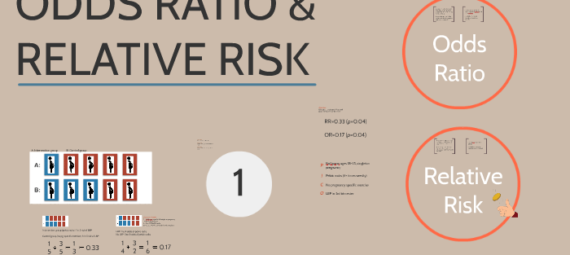Need
Researchers are often interested in evaluating the association between an exposure and an outcome. In other words, they are interested in knowing whether the presence of a risk factor or performing an intervention alters the risk of an outcome as compared to the absence of the risk factor or of the intervention (the “control” situation).
Solution: RR (Relative Risk), OR (Odds Ratio) ,THE MANTEL–HAENSZEL STATISTIC
Some Useful definitions
Observational Study
An observational study is a scientific investigation in which neither the subjects under study nor any of the variables of interest are manipulated in any way
Prospective study
A prospective study is an observational study in which two random samples of subjects are selected. One sample consists of subjects who possess the risk factor, and the other sample consists of subjects who do not possess the risk factor. The subjects are followed into the future (that is, they are followed prospectively), and a record is kept on the number of subjects in each sample who, at some point in time, are classifiable into each of the categories of the outcome variable.
Retrospective study
A retrospective study is the reverse of a prospective study. The samples are selected from those falling into the categories of the outcome variable. The investigator then looks back (that is, takes a retrospective look) at the subjects and determines which ones have (or had) and which ones do not have (or did not have) the risk factor
Relative Risk (prospective study)
Relative risk is the ratio of the risk of developing a disease among subjects with the risk factor to the risk of developing the disease among subjects without the risk factor.
The relative risk (also known as risk ratio [RR]) is the ratio of risk of an event in one group (e.g., exposed group) versus the risk of the event in the other group (e.g., nonexposed group).


We may construct a confidence interval for RR

Example


These data indicate that the risk of experiencing preterm labor when a woman exercises heavily is 1.1 times as great as it is among women who do not exercise at all.
Interpretation of RR : The value of RR may range anywhere between zero and infinity. A value of 1 indicates that there is no association between the status of the risk factor and the status of the dependent variable
Odds Ratio (retrospective study)
(When the data to be analyzed come from a retrospective study, relative risk is not a meaningful measure for comparing two groups. As we have seen, a retrospective study is based on a sample of subjects with the disease (cases) and a separate sample of subjects without the disease (controls or noncases).
The odds ratio (OR) is the ratio of odds of an event in one group versus the odds of the event in the other group

The odds for success are the ratio of the probability of success to the probability of failure.

We may construct a confidence interval for OR by the following method:
![]()
Example


We see that obese children (cases) are 9.62 times as likely as nonobese children (noncases) to have had a mother who smoked throughout the pregnancy
Interpretation of Odds ratio
The odds ratio can assume values between zero and 1. A value of 1 indicates no association between the risk factor and disease status. A value less than 1 indicates reduced odds of the disease among subjects with the risk factor. A value greater than 1 indicates
WHEN SHOULD ONE USE RISK RATIO AND ODDS RATIO?
When there is no association between exposure and outcome, both OR and RR are identical and equal to 1.0
An RR (or OR) of 1.0 indicates that there is no difference in risk (or odds) between the groups being compared. An RR (or OR) more than 1.0 indicates an increase in risk (or odds) among the exposed compared to the unexposed, whereas a RR (or OR) <1.0 indicates a decrease in risk (or odds) in the exposed group. As for other summary statistics, confidence intervals can be calculated for RR and OR.
Calculation of risk requires the use of “people at risk” as the denominator. In retrospective (case-control) studies, where the total number of exposed people is not available, RR cannot be calculated and OR is used as a measure of the strength of association between exposure and outcome. By contrast, in prospective studies (cohort studies), where the number at risk (number exposed) is available, either RR or OR can be calculated.
Reference
https://www.ncbi.nlm.nih.gov/pmc/articles/PMC4640017/
BIOSTATISTICS A Foundation for Analysis in the Health Sciences -WAYNE W. DANIEL, PH.D./ CHAD L. CROSS, PH.D., PSTAT



